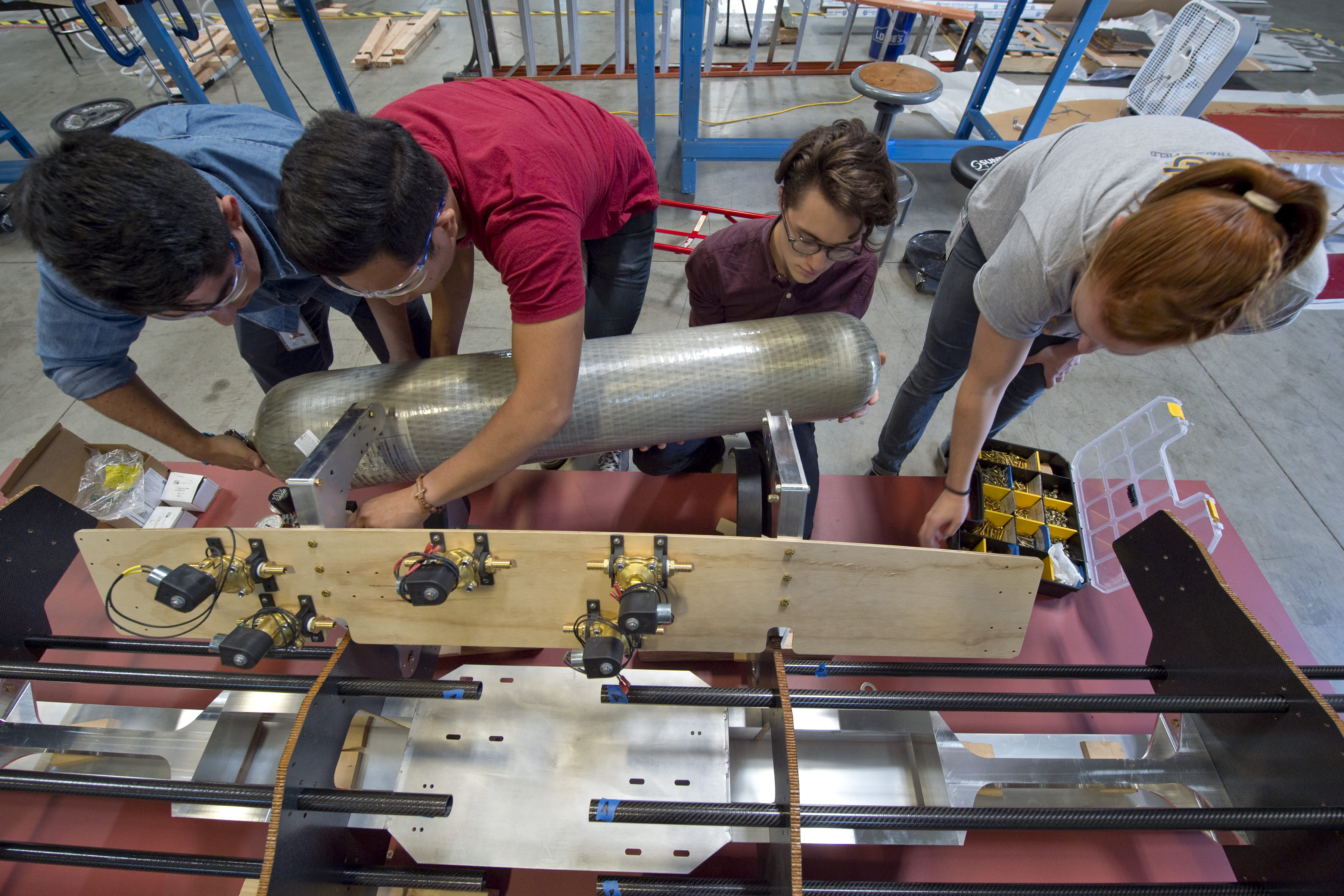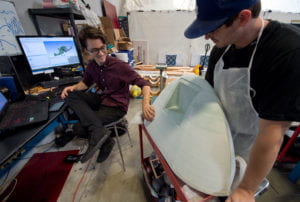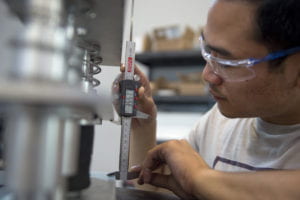Pod people
UCI students prepare their entry for Hyperloop capsule contest

“Our classes are a lot of math and theory, but this is the real thing,” says University of California, Irvine mechanical engineering senior Mackenzie Puig-Hall, her voice muffled by a respirator mask as she carefully pours the contents of a plastic cup into another receptacle.
She’s mixing ingredients to make a sticky, aromatic epoxy resin to fill cracks in a dense foam mold. A member of the HyperXite fuselage team, Puig-Hall is one of 49 UCI undergrads designing and building a prototype to enter into the Hyperloop pod competition in January.
“We’re learning the important stuff in this project and getting experience doing actual things we’re going to need to know in engineering,” she says, inside a temporary clean room that she helped build in Tustin facilities provided by Elite Aviation Products.
The interior of the mold Puig-Hall is working on will be layered with a woven fabric of carbon fiber and more epoxy. Once the resin sets up, the casing will be peeled away to reveal the raw structure of her team’s contest entry.

Steve Zylius / UCI
The surface of the mold “has to be absolutely perfect when you do the carbon layup; otherwise it’s like trying to cook with normal cookware instead of nonstick – you’ll never get it out,” says HyperXite project manager Jacob Gantz, a senior in aerospace engineering. “With our pod, you only have one shot at this. It’s $5,000 worth of carbon. We can’t mess it up.”
When SpaceX and Tesla Motors founder Elon Musk proposed the Hyperloop three years ago, his idea was to have a capsule, or pod, carry passengers and cargo through an almost airless tube over great distances at close to the speed of sound. The entrepreneur’s concept calls for a journey from Los Angeles to the San Francisco Bay Area to take about 35 minutes. To achieve this feat, the pods are going to need to be very strong, lightweight, and loaded with sophisticated systems and controls.
While Musk outlined the Hyperloop’s basics, he’s not building it. Instead, he has outsourced construction of the track to other private companies, and the work of designing and fabricating functional pods is in the hands of a diverse collection of competing engineering groups from around the world. Most of the teams, like UCI’s HyperXite, are university-based; one was formed by high-tech hobbyists on the Reddit social media website.
UCI’s entry took fifth place out of more than 125 in the Hyperloop Design Weekend contest held in Texas earlier this year, so now HyperXite is among an elite 30 or so teams building three-quarter-scale prototypes for a trial run on a mile-long test track at SpaceX headquarters in Hawthorne early next year.
The students, under the mentorship of UCI professor of mechanical & aerospace engineering Roger Rangel, bring a host of skills to the project, including structural engineering, materials science, electronics, civil engineering and computer science.
They’re pushing themselves to the limit as they labor to craft the pod and technologies to make it work in the Hyperloop tube. These include air levitation to help the vehicle travel without friction, magnetic and mechanical braking, cabin air pressure controls and suspension.

Steve Chang / UCI
While the hands-on experience is valuable, team members also recognize the strength of the foundation laid in the classroom.
“I don’t think we’d have a chance without the education we’ve gotten at UCI in aerospace, mechanical engineering, materials science, electrical engineering and the like,” says James Harvey, a mechanical engineering senior in charge of the pod’s levitation system. “Without that, it wouldn’t be going nearly so well.”
In addition to new technical skills, the students are learning how to work in a frenetic, multifaceted team setting. According to Gantz, they use a variety of online tools to plan, coordinate and communicate with each another, and they’ve developed their own unique group characteristics over the course of the project.
“We have almost 50 students, and we have this really neat culture going on,” he says. “I’ve been a part of other such endeavors, and you walk into a meeting, and it’s very quiet in there. Our meetings are really loud; there’s a lot of energy going on. The pace of our project requires that everyone be in communication with everyone else. It’s an exciting environment.”
After the design contest in late January, the teams were told to prepare their pods for a proof-of-concept run on the mile-long track this summer, but SpaceX recently pushed the date to January 2017.
“Our group will take full advantage of the extra time before the competition,” Gantz says. “We’ve been working and will continue to work as though it’ll be held this fall so that we have time to find all the unexpected problems and build a truly impressive pod.”
The HyperXite team is supported by UCI’s Henry Samueli School of Engineering and Green Initiative Fund. It also has received significant help from such Orange County-based companies as Elite Engineering Services, Pacific Composites and Huntington Mechanical Labs, among others.